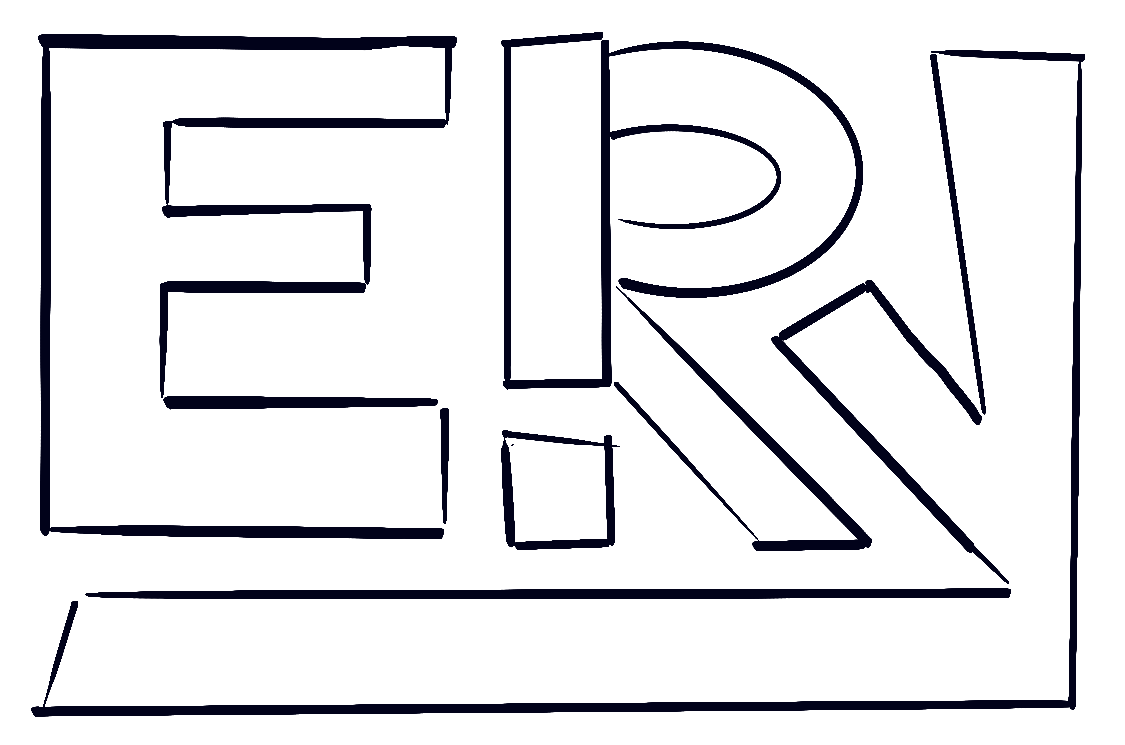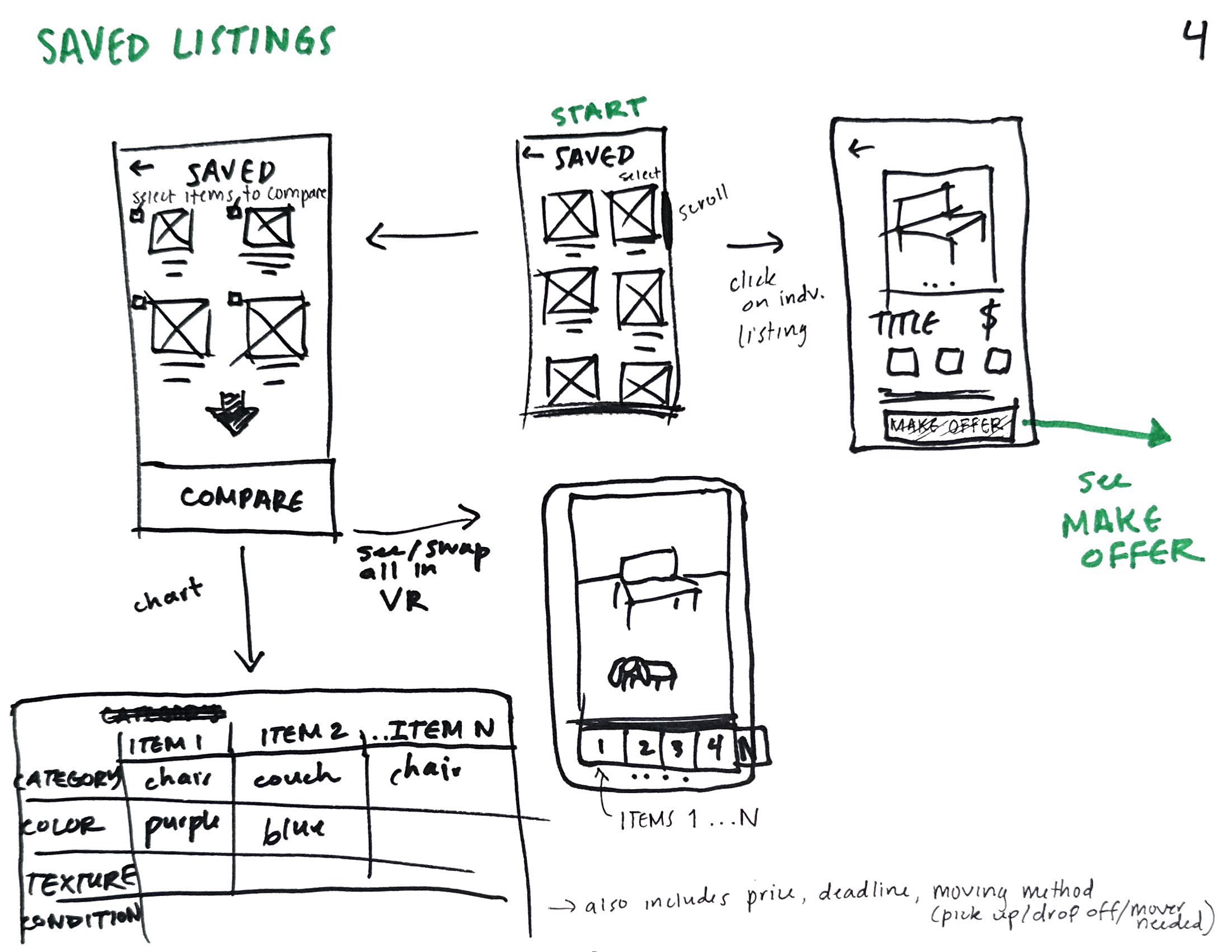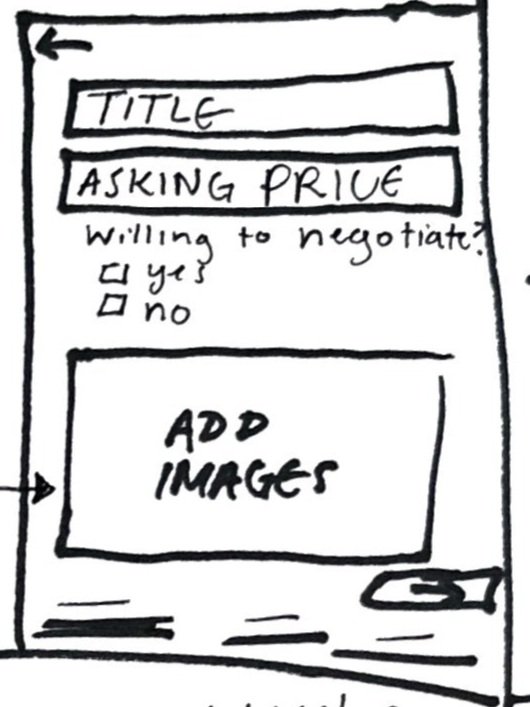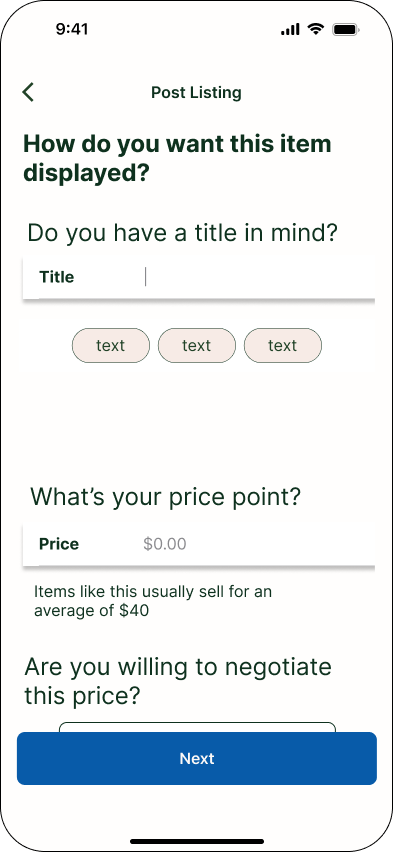Buying, Selling, & Moving Furniture with Secondhand Sofa
Project Overview
As someone who has struggled - and watched friends struggle - to furnish living spaces on a budget, I wanted to learn what problems people face in their search for furniture and how to solve them.
my roles: UX research, product design, service design
my responsibilities: competitive analysis, user interviews, JTBD, usability testing
duration: 4 months
type: capstone
The Problem
Buyers of secondhand furniture are frustrated with time-consuming searches, resulting from lack of item curation, inefficient communication, transparency issues, and messy transportation.
The Solution
A Place for Buyers, Sellers, and Movers to Unite
Secondhand Sofa forms an interconnected community of buyers, sellers, and movers of furniture to create time-efficient space for furniture exchange. This solution involves a smooth, detailed approach to posting listings and forming profiles, a way to save and compare listings, and the ability for buyers and sellers to connect with movers.
Taking a broad approach to market research
I found three key market trends:
Sustainability
Consumers increasingly seek eco-friendly options. This includes sustainable sourcing of materials, ethical treatment of workers, and a positive workplace environment. Companies that prioritize sustainability are more likely to attract customers.
Cash-and-Carry
People want to purchase and take home their furniture on the same day. Lengthy delivery wait times have been exacerbated by supply chain shortages caused by the pandemic. Offering immediate availability or quick delivery options can be a competitive advantage in the furniture industry.
E-Commerce
The current landscape of furniture commerce is experiencing a shift towards e-commerce, driven by the "Amazon effect" and further accelerated by the COVID-19 pandemic. It is crucial for furniture retailers to have a strong online presence to remain successful.
Additional challenges
shortages and supply chain issues lead to long wait times for new furniture
buyers and sellers often overlook the importance of accurately measuring their spaces and furniture items, resulting in potential size mismatches and starting over again
Current platforms
Popular options for new furniture include IKEA, Wayfair, and Bob's Discount Furniture, each catering to different budgets and offering unique features. Online platforms like Kaiyo, Chairish, AptDeco, and Craigslist provide opportunities to find pre-vetted, sustainable, and affordable pieces for used furniture. Thrift shops and antique stores also offer characterful and durable furniture options
Opportunity in the low-cost, high-curation space.
Sure, companies like Kaiyo and Charish do a great job of curating designer items, vetted and photographed by professionals. But what about common folk? What about people who are looking for quality furniture on a budget? I sought to interview people in this realm to get more information and see if this space held an opportunity.
People’s needs
When compiling data gathered from 10+ user interviews, the goals of buyers and sellers of secondhand furniture can be summarized as the following:
Buyers of secondhand furniture want to:
Sustainably furnish a home
Limit money spent on furniture
Create a space that feels like home
Furnish their home within a certain timeframe
Sellers of secondhand furniture want to:
Get items out of their space
Have smooth transactions with buyers
Communicate easily without the back and forth.
Main problems
Logistics and Transportation
Moving bulky furniture from the seller's location to the buyer's desired destination poses logistical challenges. Coordinating transportation, arranging for pickup or delivery, and associated costs can deter buyers from engaging in furniture exchanges.
Trust and Quality Concerns
Buyers have reservations about the quality and condition of secondhand furniture. Without the ability to physically inspect the items before purchase, they may worry about hidden flaws, damage, or inaccurate descriptions provided by sellers.
Lack of Curation
Buyers desire curated options that match their specific tastes and preferences. The absence of personalized recommendations or tailored search features makes it difficult for them to discover furniture items that align with their unique requirements.
Inefficient Communication
Communication hurdles between buyers and sellers can hinder the transaction process. Delayed responses, unresponsive sellers, or poor negotiation channels can contribute to missed opportunities and abandoned deals.
I thought users wanted…
Transparency and Safety
A culture of radical transparency needs to be created. Buyers, sellers, movers, AI, etc. all benefit when this is created and enforced. Buyers, sellers, movers, etc. can vet each other and their listings, transaction processes, etc.
Less Interpersonal Interaction
Humans are unreliable and inefficient. They want to think less and have easy options to save time and energy. Messages should be the last resort for communication, as this is the most time-consuming portion of other furniture platforms.
Time-Saving Automation
Adding AI and VR components into the design, with the intent of communicating clearly about their function for app users. Users will enjoy AI and AR components, but will likely want to know how these features work.
By implementing these recommendations, Secondhand Sofa could optimize user experiences, reduce manual efforts, and establish a transparent and reliable platform.
Incorporating these wants
I went to the drawing board, brainstorming tangible solutions to the problems faced while trying to meet the aforementioned goals. I did some brainstorming both by myself and with potential users using the Crazy 8 method. Here’s 1 of the 6 Crazy 8s I made.
Some other questions
How might we create an efficient, easy-to-understand method of searching for specific furniture items?
How might we consider the seemingly opposite motivations of buyers and sellers to create a product that meets the needs of both?
How might we improve the process of moving furniture for both the buyer and the seller?
How might we help sellers include necessary and helpful information in furniture listings?
Three potential solutions
Antique mall-style secondhand furniture
Brick and mortar
A kiosk helps buyers locate the items that they are looking for
Less human interaction eliminates labor which could decrease selling fees for sellers
Independent movers.
think DoorDash or Uber.
Independent movers can pick up on-demand shifts for moving furniture items or can be scheduled out in advance
Rent-a-Mover
An app that connects buyers, sellers, and movers
Similar to Facebook Marketplace but with more advanced filtering options and the mover component.
Movers - could be like rent-a-mover or could be a local moving company
Envisioning a Product
I then took many of these ideas and combined them into paper prototypes to envision what a final product could look like. I then shared the following with potential users:
Running in circles
What do the people actually want?
I was running in circles trying to solve the right problem. If any big tangents showed up, I followed them until I received consistent feedback, then further analyzed proposed solutions through a Kano analysis.
Originally, I had thought that users would want to jump into the space of AI, but this was not the case. Although people would love to see furniture in their space using augmented reality, they are not as delighted at the idea of using AI to autofill their furniture listing. Most users are weary and chose to enter data for listings on their own.
Turns out users want the following
Connect with movers
Users found it very useful to have the ability to request a mover.
See in my space
Through the use of augmented reality, users can point their cameras around their space to see how the item would look and fit.
See/Add Timeframes
Both sellers and buyers alike found it useful to have deadlines for the buying and selling of an item.
Some Iterating
Hiring a Professional
At first, I thought that making tasks as few steps as possible was smart, but I soon realized there were missing components and a lot of unintended mental strain. From the sketches to iteration 1.0, users selected a day for a professional to get in touch with them. But how? When? How long would this be?
By the time I got to the third iteration, I had users select a day and a time frame. Professionals will then reach out to see if its best to meet in person or via video-chat.
Setting Up a Listing
Similar to hiring a professional iterations, setting up a listing was condensed in a way that made the process less efficient.
I ended up breaking each piece into small manageable steps instead of including everything on the same screen.
Making the mark
Users agreed that Secondhand Sofa is easy and delightful to use.
CSAT
100
100
Prototype 1
Prototype 2
60
NPS
20
92.5/100
SUS
84.5/100
Is Secondhand Sofa worth promoting and sharing?
According to usability test participants, the app is worth promoting. The net promoter score rose from a 20 in the first round of testing to a 60 in the second round. Participants made comments such as:
“I would use Secondhand Sofa if I knew it existed.”
“When are you going to develop this?”
“I would definitely use this”
With high NPS, CSAT, and SUS scores, I decided to wrap up work on Secondhand Sofa. With a focus on sustainability, affordability, and efficient communication, this product will improve the way users engage in buying, selling, and moving furniture within a connected and transparent community. The positive feedback from usability testing indicates the app's potential for success and user adoption.
What I’m walking away with
People have conflicting opinions about over AI
When I was conducting user testing, I ran the idea of taking a video of an item and the app automatically generating the listing for users to check before posting. Most people said they’d rather fill out the listing themselves than use this time-saving AI. People are okay with the use of technology in some ways, but very hesitant in other ways. It is important to comfortably ease people into using new and potentially confusing technologies.
Lots of ideas in the trash
I found that most solutions I generated, even with ample user data, were thrown out the window. Until I truly got to know my users, which is a continuous process, I was unable to come up with solutions truly useful to them. The design process is not linear - it is messy, creative, beautiful, etc. Although the design process is messy and unpredictable, I was grounded in empathy for my users and drive to create a solution for them. I know that these are skills I will take forward with me.

































